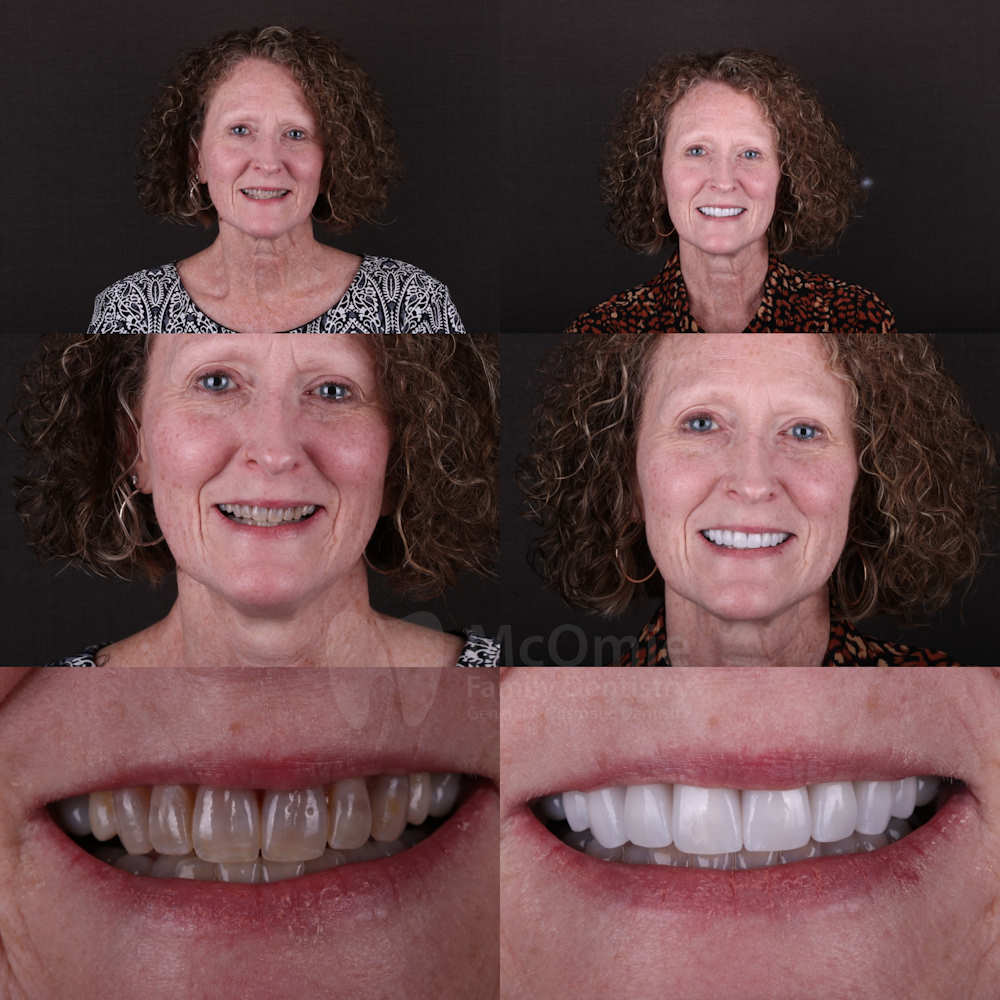If whitening has not touched gray or banded staining, you are not alone. Tetracycline stains form inside the tooth while it develops, so surface treatments rarely make a big change. This guide explains what actually works, when each option makes sense, and shows a real Chattanooga case from our office.
What Are Tetracycline Stains
Tetracycline is an antibiotic that, when taken during tooth development, can permanently discolor adult teeth. The result is often horizontal bands or a general gray tone beneath the enamel. Because the color is intrinsic, typical whitening cannot reach it well. Treatment plans focus on masking the discoloration rather than bleaching alone.
Whitening: When It Helps and When It Does Not
Whitening is useful for surface stains from coffee, tea, or tobacco, and it may slightly brighten mild intrinsic discoloration. For deep gray bands the results are limited. Many patients still whiten lower teeth or other untreated areas so the final smile looks even after veneers or crowns on the upper arch. Think of whitening as a supporting player for true tetracycline staining.
Why Whitening Struggles With Banding
Intrinsic stains sit within the tooth structure, not on the surface. Even strong professional gels have a hard time moving color that deep. You may see a slightly lighter version of the same bands rather than a uniform shade change. The goal becomes controlling how light travels through the tooth so the eye no longer reads the dark stripes.
Composite Bonding: A Bridge Solution
Composite bonding can be a same day, budget friendly way to test a lighter shade or improve small areas. The challenge is predictability. Dark bands can show through and resin edges may pick up stain over time. For light cases or as a short term improvement bonding makes sense. For moderate to severe staining porcelain usually provides a more stable and natural result.
When Bonding Is a Smart Step
Bonding is helpful to preview color and shape before investing in ceramics or to treat small areas where a full veneer is not necessary. If you choose bonding first we will review maintenance so edges stay smooth and the color stays fresh.
Porcelain Veneers: Why They Often Win
Porcelain veneers are thin ceramic shells designed to mask internal discoloration while keeping a natural translucency. With proper planning they hide banding, refine shape, and bring the overall color into a believable range. Shade strategy matters. Many patients treat the visible upper smile line so every tooth that shows when you smile matches. When existing fillings are large or the starting shade is very dark a combination of veneers and a few crowns can deliver the best blend of strength and coverage.
How We Avoid a Flat or Opaque Look
Well done veneers allow a touch of natural light at the edges and near the gumline. We plan this with close up photos, shade tabs in multiple lights, and a temporary preview. Patients can see that the final result looks bright without looking artificial.
A Note on Materials
Different ceramics handle masking and translucency differently. For moderate stains layered porcelain often gives a lifelike result. For deeper banding a zirconia based veneer may be used on select teeth to increase masking while keeping a natural look overall.
Before and After Case: Tetracycline Stains Treated with Zirconia Ceramic Veneers
Tetracycline was prescribed more often decades ago. When children took it while their adult teeth were forming, it could leave permanent banding or gray discoloration. Many people now in their fifties and early sixties still have this type of staining.
In this case, Dr. Mark McOmie used custom zirconia ceramic veneers to mask the discoloration and create a brighter, natural-looking smile. If whitening has not helped banded or gray stains, a quick consult can confirm whether veneers or crowns are the better option for your teeth and bite.

When Crowns Are the Better Choice
Crowns cover the entire tooth and give more control over very dark shades or heavily restored teeth. They are helpful when strength is a priority on back teeth. Many plans combine approaches. Some teeth get veneers for minimal shaping and natural edge translucency. Others get crowns for added masking and durability. Your exam, photos, and bite evaluation guide those choices.
When We Mix Veneers and Crowns
Very dark or heavily filled corner teeth might benefit from crowns for extra masking and strength while the front teeth get veneers for a softer edge and more translucency. Blending approaches keeps the result durable and natural.
How Many Teeth Should Be Treated
The number depends on how wide you smile and the original shade. Most patients choose six, eight, or ten across the upper arch. Lower teeth are often whitened to harmonize with the final color on top. During your consult we review photos and a mirror together so you can see exactly which teeth show from the front and at the corners of your smile.
Your Tetracycline Stain Choices at a Glance
- Whitening freshens surface stains and helps match untreated teeth but rarely erases deep bands.
- Composite bonding improves small areas and budgets but may not fully mask dark stripes and can stain over time.
- Porcelain veneers balance masking power, natural look, and longevity for most moderate to severe cases.
- Crowns add full coverage and strength when teeth are very dark or already heavily filled.
What Determines the Best Option for You
Three factors guide the plan: how deep the original stain is, how many teeth show when you smile, and the condition of each tooth. Photos and a simple exam answer most questions. If stains are lighter and teeth are mostly intact veneers are often enough. If some teeth already have large fillings or crowns we may recommend a combination so everything matches and lasts.
FAQ
Do veneers completely hide tetracycline bands
Often yes, especially with the right material and shade plan. Severe cases may mix veneers and a few crowns.
How long do porcelain veneers last
With good home care, regular cleanings, and protection from grinding many last ten to fifteen years or more.
Can I try whitening first
Yes. It can help harmonize lower teeth even if it does not fully resolve the intrinsic stain.
Ready to Talk Through Your Options
A short consult can confirm whether veneers, crowns, or a combination will give you the color and confidence you want. Bring any past whitening history and a few smile photos. We will map out a clear plan and timeline that fits your goals.




